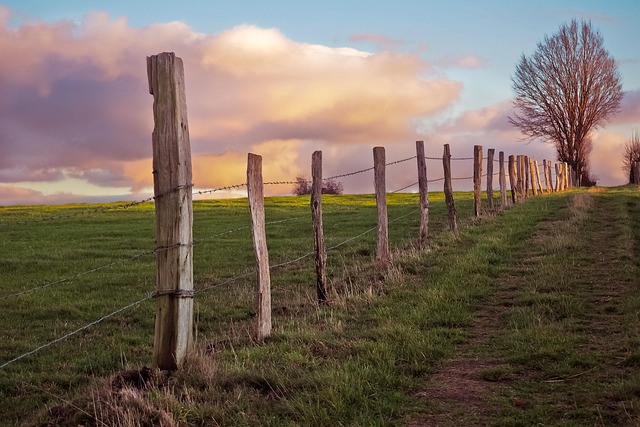Large properties present unique fencing challenges, requiring robust yet cost-efficient solutions. This article explores diverse options to transform your expansive space without breaking the bank. We delve into understanding specific large-property fencing needs, evaluating traditional materials’ costs and drawbacks, and uncovering modern alternatives. From biofencing’s ecological benefits to DIY installation tips, this guide offers a comprehensive approach to achieving secure, beautiful boundaries within budget constraints.
- Understanding Fencing Needs for Large Properties
- Traditional Fencing Options: Costs and Limitations
- Cost-Effective Alternatives: A Look at Modern Materials
- Natural Barriers: The Benefits of Biofencing
- DIY vs. Professional Installation: Saving on Costs
- Long-Term Savings: Maintenance and Durability Considerations
Understanding Fencing Needs for Large Properties
Large properties come with unique fencing challenges. The extensive perimeter often requires a robust yet cost-effective solution that can withstand potential environmental stresses, such as strong winds and heavy rainfall. Additionally, privacy and security are paramount considerations, necessitating fences that offer both visual barrier and protection against unwelcome intruders.
These properties may also demand aesthetically pleasing options that complement the overall landscape design. Versatile fencing materials like vinyl, wood, or chain link can be tailored to meet these needs, providing various styles and colors to enhance curb appeal while remaining budget-friendly. Understanding these specific requirements is key to selecting the right fencing solution for large properties, ensuring both functionality and visual harmony.
Traditional Fencing Options: Costs and Limitations
Traditional fencing options, while aesthetically pleasing for many properties, can come with a hefty price tag and limitations that make them less ideal for large-scale applications. The cost of materials like wood or metal pickets adds up significantly over vast distances, making it an expensive endeavor to enclose extensive land areas. Moreover, these conventional fences often require regular maintenance, including painting, sealing, or replacement of damaged panels, which can drain time and resources.
Another limitation is their lack of adaptability. Standard fencing designs may not suit the unique topography or specific security needs of large properties. The installation process for traditional fences is labor-intensive, making it less feasible for extensive projects that demand speed and efficiency. These factors contribute to higher overall costs, making them a less cost-effective solution for large properties seeking secure and sustainable enclosure options.
Cost-Effective Alternatives: A Look at Modern Materials
In today’s market, homeowners seeking to fence large properties no longer have to settle for traditional, expensive options. Innovative modern materials offer cost-effective alternatives that are both durable and aesthetically pleasing. For instance, vinyl fencing has gained immense popularity due to its low maintenance requirements and competitive pricing compared to wood or metal. Not only does it resist rot and pests, but it also offers a wide range of styles and colors to suit various tastes.
Another promising material is composite fencing, made from a blend of recycled plastic and wood fibers. This eco-friendly option boasts excellent resistance to fading, cracking, and warping, ensuring longevity even in harsh weather conditions. Moreover, composite fencing requires minimal maintenance, further reducing long-term costs. These modern materials not only provide practical benefits but also contribute to a more sustainable future, making them attractive choices for cost-conscious homeowners looking to enhance their large properties without breaking the bank.
Natural Barriers: The Benefits of Biofencing
Natural barriers have gained significant popularity as an eco-friendly alternative to traditional fencing. Biofencing, also known as living fencing or hedging, involves using plants and vegetation to create a protective border. This method offers numerous advantages for large properties. Not only does it provide privacy and security but also serves as a natural habitat for local wildlife, promoting biodiversity. Plants act as a biological buffer against noise pollution, providing a serene environment for residents and reducing the need for mechanical maintenance compared to conventional fences.
Biofencing is an aesthetically pleasing option that can enhance the curb appeal of large estates. Native plant species are often used, which require less care and water, making them cost-effective in the long run. Additionally, these natural barriers can be designed to suit specific property needs, offering flexibility and customization for homeowners. This sustainable approach not only reduces environmental impact but also creates a dynamic, ever-evolving landscape feature that adds character to any large property.
DIY vs. Professional Installation: Saving on Costs
When considering fencing for a large property, one of the primary concerns is often the cost. A common strategy to reduce expenses is to decide between DIY installation and professional services. While doing it yourself (DIY) may seem appealing due to its potential savings, it’s essential to weigh the long-term benefits of professional installation.
Hiring fencing experts offers several advantages. Firstly, they bring specialized knowledge and experience, ensuring your fence is installed correctly from the start, which minimizes the risk of future repairs or replacements. Professionally installed fences are also likely to last longer, saving you money in the long run. Additionally, many contractors offer competitive pricing for large-scale projects, sometimes even providing packages that include materials and labor, making it a cost-effective choice.
Long-Term Savings: Maintenance and Durability Considerations
Investing in fencing for a large property is a significant decision, but cost-effective solutions exist that go beyond initial installation costs. One of the most compelling advantages is the potential for long-term savings through reduced maintenance and increased durability. Traditional fences often require regular cleaning, painting, or replacement parts to maintain their integrity, which can add up over time. However, modern fencing materials and designs offer enhanced resilience to weathering, rust, and decay.
Durable fencing options like vinyl, metal, or treated wood are designed to withstand harsh environmental conditions, reducing the need for frequent maintenance. These materials are often backed by extensive warranties, ensuring their longevity. By choosing a high-quality fence with proper installation, property owners can expect a robust barrier that requires minimal upkeep, ultimately saving time and money in the long run.
